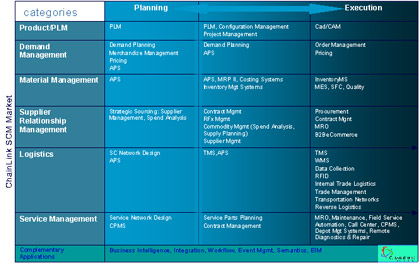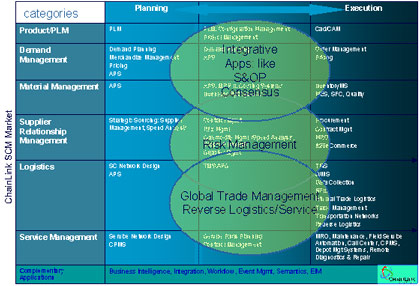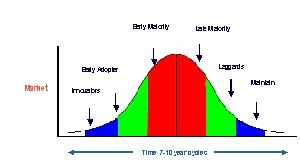|
By Ann Grackin
Here
we are in the New Year. So, what should
the going forward picture be of the Supply Chain portfolio?
Something old, something new, something from a service
provider, something blue (figure 1). OK, enough of that.
Something Old
In spite of the press, people are continuing to buy and implement
solutions from APS to WMS, although at a slower rate. In figure
1, The 2002 Portfolio, we define planning to be more strategic:
setting up of supply chains, strategic sourcing, etc.—basically
designing chains, trade lanes, selecting outsource partners,
etc.—optimizing the pipeline. These efforts have actually
taken on more prominence since the push to outsourcing.
More and more, though, there is a process blur between a
more tactical planning exercise (monthly weekly daily) and
executional
processes. From the planning view, since firms produce and
schedule production based on planning systems, this makes
sense. And from the so-called execution level, many of the
platform
players are providing more algorithms to rapidly replan as
conditions change.

Figure 1
(click chart to see larger image)
Something New!
However, a new era of supply chain performance is beginning.
Spending ten years in the asset optimization effort has gotten
firms to leaner processes and faster cycle times. But we have
to destroy time—it’s still in the way!
We are moving to applications that get us to the power now!
Real-time is real. So as far as planning and optimization
goes, these solutions will not become obsolete. But by their
very
nature they rely on the past to function. Historical data
drives their models. However, these systems will be enhanced
by significantly
improved and more timely, accurate information, provided
by systems that deliver the NOW.
Big Trends for business going forward are about pure visualization
of the customer, and finding ways to integrate the supply
chain elements that fulfill that demand. If you think about
this
in the broadest sense, it spools out some important technology
plays:
- Systems of the Now:
- RFID is but one
- Building on the network platform will
be a key effort. Network providers are putting
more on the platform. And
as firms become
more comfortable with this approach, they
will utilize those added apps on these near real-time
platforms.
Lower total
cost of ownership and quick time to benefit
make
this a compelling
approach.
- Integrative Technologies—I did not say integration technologies. This is about higher order decisions
making, that brings together cross functional decision making,
like
Consensus Planning S&OP, ECO/EOLs etc., Balanced
Score Carding etc. (figure 2)
- Predictive Systems—when
should I make a move and corner the market on Kiwis?
How long/when will a part, product or
system fail—this deviation from pattern, or new
pattern means something big is going to happen. These
systems will
unbind time, enabling not only visibility of the
current scenarios, but allowing predictive views. They
can allow
us to create
new strategies or mitigate risk[1].

Figure 2
2004 will be a Year of Investments
So, that’s interesting, but the word was that the market
is still not spending. That’s true—on older models.
It wants newer models—really!
The fact is, we have gone some distance in SCM, but there
are still big problems to solve. You are planning a new fab,
or opening in a new market. These are huge plays, so companies
still want to get Demand right. Investments in supply cost
a lot! End-users endeavor to try new ways to solve some of
these basic problems, even if it takes a sliver off, solving
10% of the problem. Iteratively, smart companies keep at it
and keep improving.
I recently read some advice in a magazine that told users
to ‘dust off their old ROI model’ and use them.
Balderdash! Studies have shown that we move through the technology
adoption to legacy in 7-10 year cycles. 
APS and ERP emerged in the ’93 to ’94 time frame.
So, it’s 10 years on. And the business models that the
software supports are radically different than 1993. Oh, CIO,
that last century idea of one application linking the enterprise
cost a lot of money, and it’s still not implemented.
SmallSmartFast organizations fueled by outsourced relationships
and enabled by network technologies have quietly been becoming
ubiquitous. These new business models present new problems,
but also give us a parallax view, if you will, of the old problems.
But let’s give some credit to technology, here! It is
a fact that it does make so many things possible! It is so
pedestrian to be negative on tech. Leaders want solutions,
not observers!
Future Forward
Some redefining of how we look at supply chain problems is
going on, enabled by innovation. Consistently, our research
has shown that big companies have been building ‘garages’ in
the back, funding new efforts that are redefining and solving
these new problems. A whole lot of coding going on! That means
COTS vendors did not solve that problem for them. So, if you
are one of those software vendors of yore, you need to get
your head out of the 2002 blues and start anticipating what
issues the customer is concerned with now. Revisionists went
the way of the Berlin Wall.
Think The Power of Now!
[1]
ChainLink will be rolling out Future Forward models on what
users are
doing now, as well as where they are
going to buy to solve.
©2004
ChainLink Research, Inc.
|


